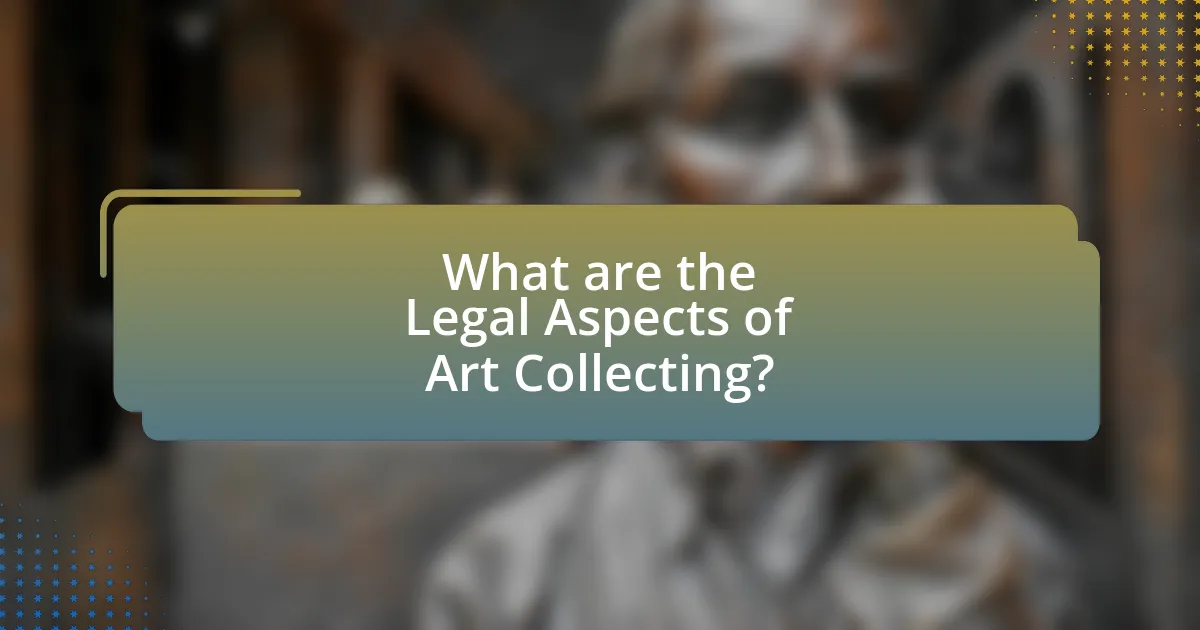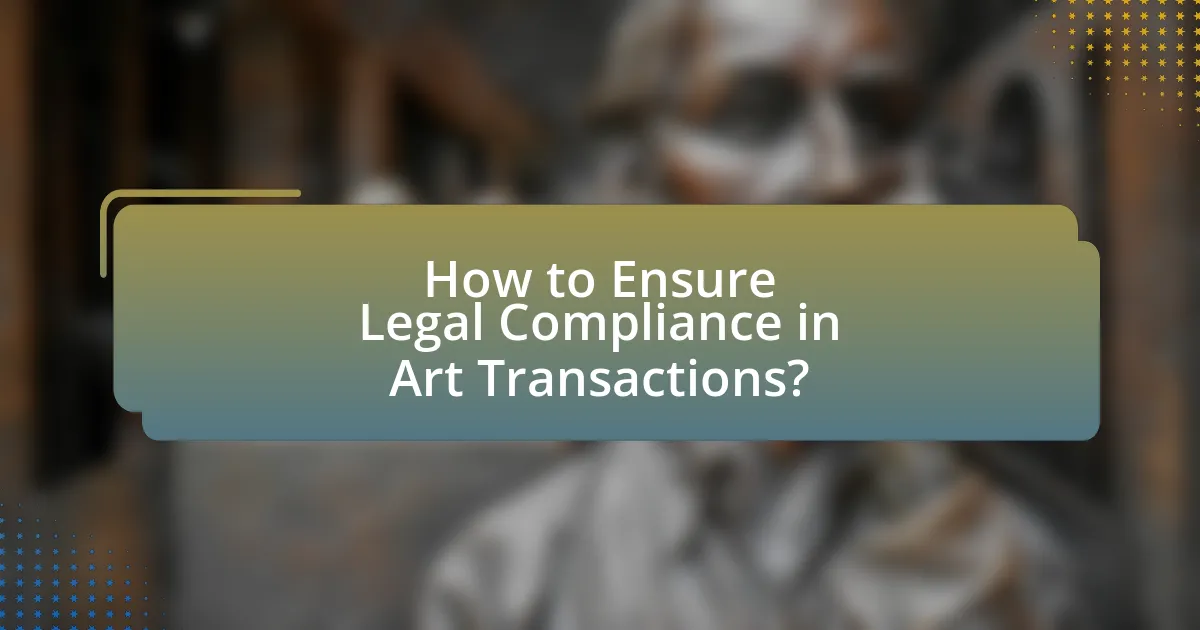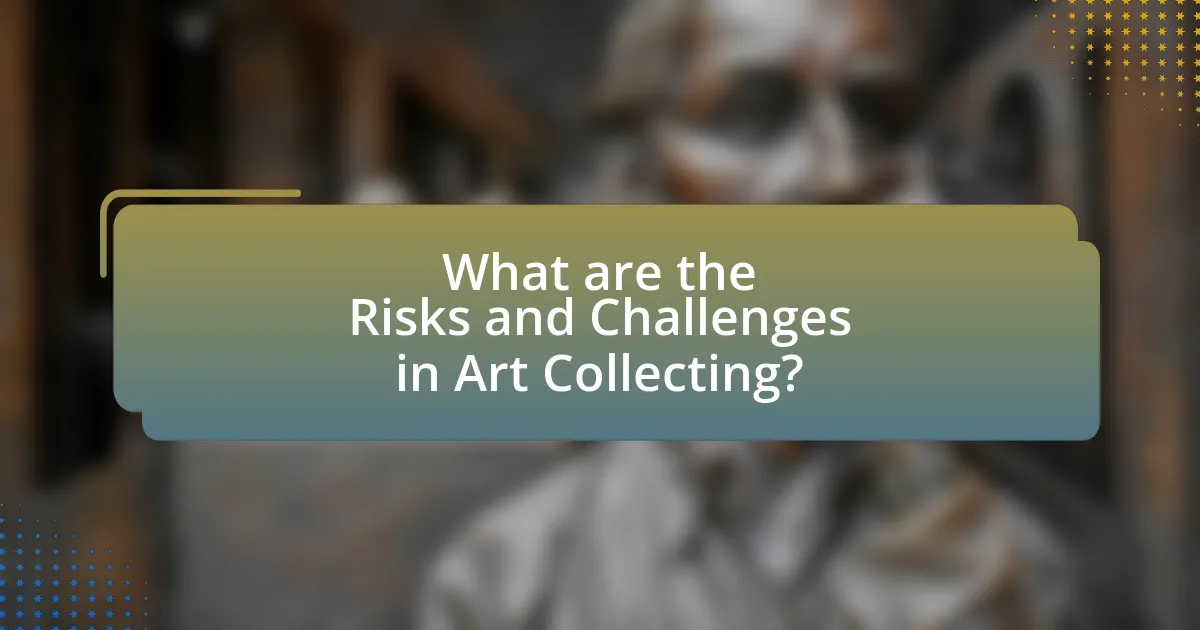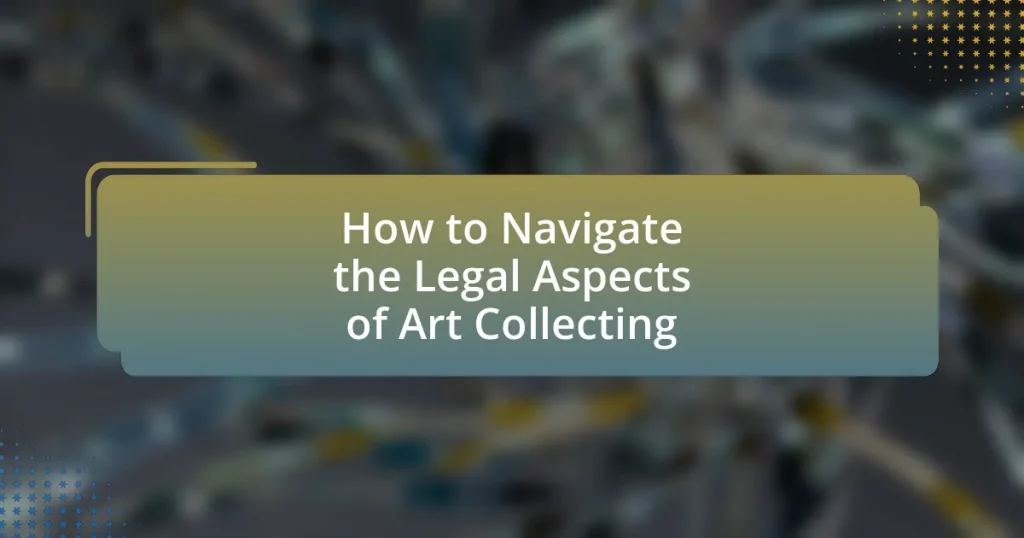The article focuses on the legal aspects of art collecting, emphasizing the importance of understanding ownership rights, provenance verification, copyright issues, and compliance with international laws. It outlines the potential legal challenges collectors may face, such as authenticity disputes and copyright infringement, and highlights the significance of due diligence in verifying provenance to avoid acquiring stolen or counterfeit works. Additionally, the article discusses best practices for ensuring legal compliance in art transactions, including the necessity of written contracts and proper documentation, while providing resources for legal advice tailored to art collectors.

What are the Legal Aspects of Art Collecting?
The legal aspects of art collecting encompass ownership rights, provenance verification, copyright issues, and compliance with international laws. Ownership rights determine who legally possesses the artwork, while provenance verification ensures the artwork’s history is legitimate and free from theft or forgery. Copyright issues arise when reproducing or displaying art, as artists retain certain rights over their creations. Compliance with international laws is crucial, especially regarding cultural property and export regulations, which can vary significantly by country. For instance, the UNESCO Convention on the Means of Prohibiting and Preventing the Illicit Import, Export, and Transfer of Ownership of Cultural Property establishes guidelines that collectors must follow to avoid legal complications.
Why is understanding legal aspects important for art collectors?
Understanding legal aspects is crucial for art collectors to protect their investments and ensure compliance with laws governing ownership, provenance, and intellectual property. Legal knowledge helps collectors navigate issues such as title disputes, authenticity verification, and copyright infringement, which can significantly impact the value and legitimacy of their collections. For instance, the Art Loss Register estimates that around 50% of stolen art remains unrecovered, highlighting the importance of due diligence in verifying provenance to avoid acquiring stolen works. Additionally, understanding contracts and agreements can prevent potential legal disputes with galleries, auction houses, and other collectors, ensuring a smoother transaction process.
What legal issues can arise in art collecting?
Legal issues in art collecting can include provenance disputes, copyright infringement, and issues related to authenticity. Provenance disputes arise when the ownership history of an artwork is unclear or contested, potentially leading to claims of theft or fraud. Copyright infringement can occur if collectors reproduce or display works without permission from the copyright holder, violating intellectual property laws. Additionally, issues of authenticity may arise if a piece is misrepresented as an original or by a specific artist, leading to legal ramifications for misrepresentation or fraud. These legal challenges underscore the importance of thorough due diligence in art transactions.
How can legal knowledge protect art collectors?
Legal knowledge protects art collectors by enabling them to understand and navigate the complexities of ownership rights, provenance verification, and contractual obligations. This understanding helps collectors avoid legal disputes over authenticity, title, and potential claims from third parties. For instance, knowledge of copyright laws can prevent infringement issues when displaying or reproducing artworks. Additionally, familiarity with the Uniform Commercial Code (UCC) assists collectors in ensuring proper documentation and transfer of ownership, thereby safeguarding their investments. Legal knowledge also empowers collectors to conduct due diligence, such as verifying the provenance of artworks, which is crucial in preventing the acquisition of stolen or looted pieces.
What are the key legal terms every art collector should know?
Key legal terms every art collector should know include provenance, title, copyright, and due diligence. Provenance refers to the history of ownership of a piece of art, which is crucial for establishing authenticity and value. Title indicates the legal ownership of the artwork, ensuring that the collector has the right to buy, sell, or display it. Copyright protects the creator’s rights over their work, impacting how the art can be reproduced or displayed. Due diligence involves the research and verification process a collector undertakes to ensure the legitimacy of the artwork and the seller, minimizing the risk of fraud or legal disputes. Understanding these terms is essential for navigating the complexities of art collecting and ensuring legal compliance.
What is provenance and why is it significant?
Provenance refers to the history of ownership of a piece of art or an artifact, detailing its origins and the sequence of its transfers from one owner to another. Provenance is significant because it establishes authenticity, helps in assessing the value of the artwork, and provides legal protection against claims of theft or forgery. For instance, artworks with well-documented provenance are often more valuable in the market, as they assure buyers of the piece’s legitimacy and legal status, reducing the risk of acquiring stolen or counterfeit items.
How does copyright affect art ownership?
Copyright grants the creator of an artwork exclusive rights to its reproduction, distribution, and public display, which directly impacts art ownership. While owning a physical piece of art allows the owner to display or sell it, copyright ownership remains with the artist unless explicitly transferred. This means that the art owner cannot legally reproduce or commercially exploit the artwork without permission from the copyright holder. For instance, under the U.S. Copyright Act, the creator retains rights for the life of the author plus 70 years, reinforcing the distinction between physical ownership and copyright ownership. Therefore, understanding copyright is essential for art collectors to navigate the legal aspects of their acquisitions effectively.

How to Ensure Legal Compliance in Art Transactions?
To ensure legal compliance in art transactions, parties must conduct thorough due diligence, including verifying the provenance of the artwork and ensuring that all necessary documentation, such as bills of sale and certificates of authenticity, are in order. Provenance verification is crucial as it establishes the artwork’s ownership history, which can prevent disputes and claims of theft. Additionally, compliance with local and international laws regarding art trade, such as export and import regulations, is essential to avoid legal repercussions. For instance, the UNESCO Convention on the Means of Prohibiting and Preventing the Illicit Import, Export and Transfer of Ownership of Cultural Property mandates that countries protect their cultural heritage, making adherence to such regulations vital for legal transactions.
What steps should be taken before purchasing art?
Before purchasing art, potential buyers should conduct thorough research on the artwork, the artist, and the provenance. This includes verifying the authenticity of the piece, understanding its market value, and reviewing any legal documentation related to ownership and rights. Provenance, which refers to the history of ownership, is crucial as it can affect the artwork’s value and legality. According to a report by the Art Loss Register, artworks with clear provenance are less likely to be subject to disputes or claims of theft, reinforcing the importance of this step. Additionally, buyers should consider consulting with art experts or legal advisors to navigate any potential legal issues that may arise during the purchase process.
How can collectors verify the authenticity of a piece?
Collectors can verify the authenticity of a piece by obtaining a certificate of authenticity from a reputable source, such as the artist, gallery, or an established authentication expert. This certificate typically includes details about the artwork, such as its provenance, condition, and any relevant historical context. Additionally, collectors can seek third-party appraisals from recognized experts in the field, who can provide an independent assessment based on established criteria and market standards. Provenance research, which traces the ownership history of the piece, also plays a crucial role in confirming authenticity, as it can reveal any discrepancies or forgeries associated with the artwork.
What role do contracts play in art transactions?
Contracts serve as legally binding agreements that outline the terms and conditions of art transactions. They establish the rights and obligations of both the buyer and the seller, ensuring clarity regarding payment, delivery, ownership, and any warranties or representations about the artwork. For instance, a contract can specify the provenance of the art, which is crucial for verifying authenticity and value. Additionally, contracts protect both parties in case of disputes, providing a framework for resolution based on the agreed-upon terms. This legal structure is essential in the art market, where high-value transactions and potential fraud necessitate clear documentation to safeguard interests.
What are the legal considerations for selling art?
The legal considerations for selling art include copyright issues, authenticity verification, and compliance with local laws. Sellers must ensure that they own the rights to the artwork or have permission from the copyright holder to sell it, as unauthorized sales can lead to legal disputes. Additionally, verifying the authenticity of the artwork is crucial to avoid fraud claims, which can involve provenance documentation and expert appraisals. Compliance with local laws, such as sales tax regulations and import/export restrictions, is also necessary to avoid legal penalties. These considerations are essential for maintaining legal integrity in art transactions.
What disclosures are required when selling art?
When selling art, sellers are required to disclose any material facts that could affect the buyer’s decision, including the artwork’s provenance, condition, and authenticity. Provenance refers to the history of ownership, which can significantly impact the artwork’s value and desirability. Sellers must also provide information about any restoration or alterations made to the piece, as these can influence its marketability. Additionally, if the artwork is subject to any legal claims or disputes, this must be disclosed to the buyer. These requirements are often guided by laws and regulations in various jurisdictions, ensuring transparency and protecting both parties in the transaction.
How can sellers protect themselves legally during a sale?
Sellers can protect themselves legally during a sale by ensuring that all agreements are documented in writing. Written contracts should clearly outline the terms of the sale, including the price, payment method, and any conditions or warranties. This practice is supported by the Uniform Commercial Code, which emphasizes the importance of written agreements in commercial transactions to avoid disputes. Additionally, sellers should verify the buyer’s identity and financial capability to complete the purchase, which can mitigate the risk of fraud. Implementing these measures creates a legally binding framework that safeguards the seller’s interests throughout the transaction.

What are the Risks and Challenges in Art Collecting?
The risks and challenges in art collecting include issues of authenticity, provenance, market volatility, and legal disputes. Authenticity concerns arise when collectors purchase artworks that may be counterfeit or misattributed, leading to financial loss. Provenance, or the history of ownership, is crucial; lack of clear provenance can result in legal claims from previous owners or heirs. Market volatility poses a risk as art values can fluctuate significantly, impacting investment returns. Legal disputes may arise over copyright issues, title claims, or contractual obligations, complicating ownership and resale. Collectors must navigate these challenges to protect their investments and ensure compliance with legal standards.
What legal risks do art collectors face?
Art collectors face several legal risks, including issues related to provenance, authenticity, and intellectual property rights. Provenance refers to the history of ownership of an artwork; if an artwork has a disputed or unclear provenance, collectors may face legal challenges regarding its rightful ownership. Authenticity concerns arise when artworks are misrepresented as original or by a specific artist, leading to potential fraud claims. Additionally, intellectual property rights can pose risks if collectors do not have the proper licenses for reproducing or displaying artworks, which can result in copyright infringement lawsuits. These risks highlight the importance of thorough due diligence and legal advice in art transactions.
How can collectors mitigate the risk of art theft?
Collectors can mitigate the risk of art theft by implementing comprehensive security measures, including installing advanced surveillance systems and employing professional security personnel. These measures are essential as art theft is a significant issue, with the FBI estimating that art theft costs the industry over $6 billion annually. Additionally, collectors should maintain detailed records of their artworks, including provenance and appraisals, which can aid in recovery if theft occurs. Insurance policies specifically designed for art collections can also provide financial protection and facilitate recovery efforts.
What are the implications of art market fluctuations?
Art market fluctuations can significantly impact the valuation, liquidity, and investment strategies of collectors and investors. When the art market experiences volatility, the prices of artworks can rise or fall dramatically, affecting the perceived value of collections and the potential for resale. For instance, during economic downturns, art prices may decline, leading to decreased liquidity for collectors looking to sell. Conversely, during periods of economic growth, demand for art can increase, driving prices up and enhancing investment returns. Historical data shows that the art market can mirror broader economic trends, with the Artprice Global Index indicating that art prices can fluctuate in response to changes in consumer confidence and wealth distribution.
How can collectors navigate disputes related to art ownership?
Collectors can navigate disputes related to art ownership by thoroughly documenting provenance and maintaining clear records of transactions. Provenance, which refers to the history of ownership of a piece of art, is crucial in establishing rightful ownership and can help resolve disputes. Additionally, collectors should seek legal advice from attorneys specializing in art law to understand their rights and obligations. Engaging in mediation or arbitration can also provide a less adversarial means of resolving conflicts, as these methods are often faster and less costly than litigation. Collectors should be aware of relevant laws, such as the Visual Artists Rights Act, which can impact ownership rights and moral rights associated with artworks.
What are common types of disputes in art collecting?
Common types of disputes in art collecting include authenticity issues, provenance disputes, and contractual disagreements. Authenticity issues arise when collectors question whether a piece is genuinely created by the claimed artist, often leading to legal battles over the artwork’s legitimacy. Provenance disputes occur when there are conflicting claims regarding the ownership history of an artwork, which can affect its value and marketability. Contractual disagreements typically involve disputes over the terms of sale, including payment terms, delivery conditions, and representations made by sellers. These disputes can significantly impact the financial and legal standing of collectors in the art market.
How can mediation or arbitration resolve art-related conflicts?
Mediation and arbitration can effectively resolve art-related conflicts by providing a structured, neutral platform for parties to negotiate and reach mutually acceptable solutions. Mediation involves a facilitator who helps the disputing parties communicate and explore options, while arbitration entails a neutral third party making a binding decision based on the evidence presented. Both methods are often faster and less costly than traditional litigation, which is particularly beneficial in the art world where relationships and reputations are crucial. For instance, the American Arbitration Association reports that arbitration can reduce resolution time by up to 50% compared to court proceedings, making it an attractive option for artists, collectors, and galleries facing disputes.
What best practices should art collectors follow for legal safety?
Art collectors should ensure legal safety by conducting thorough due diligence on artworks before purchase. This includes verifying provenance, which is the history of ownership of the artwork, to confirm its authenticity and legal status. Collectors should also obtain written agreements that clearly outline the terms of sale, including any warranties or representations made by the seller. Additionally, maintaining comprehensive documentation, such as invoices and certificates of authenticity, is crucial for establishing ownership and value. Engaging legal counsel experienced in art law can further safeguard against potential disputes or claims. These practices are essential as they help mitigate risks associated with art theft, forgery, and title disputes, which are prevalent in the art market.
How can collectors maintain proper documentation for their collections?
Collectors can maintain proper documentation for their collections by systematically cataloging each item with detailed records that include provenance, purchase receipts, and condition reports. This practice ensures that collectors have a comprehensive history of each piece, which is crucial for legal ownership verification and potential resale. Provenance documentation, for instance, can significantly enhance an artwork’s value and authenticity, as noted in the 2018 report by the International Foundation for Art Research, which emphasizes the importance of maintaining accurate records to prevent disputes and establish rightful ownership.
What resources are available for legal advice in art collecting?
Legal advice resources for art collecting include specialized law firms, art law associations, and online legal platforms. Specialized law firms often have attorneys with expertise in art law, providing tailored legal services for collectors. Art law associations, such as the Art Law Section of the American Bar Association, offer networking opportunities and resources for legal guidance. Online legal platforms, like LegalZoom or Rocket Lawyer, provide accessible legal documents and consultations for art collectors. These resources ensure that collectors can navigate legal complexities effectively, protecting their investments and rights.















